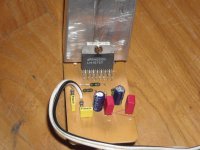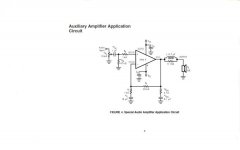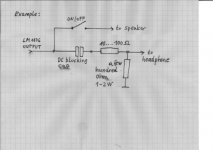hello.
two years ago i built a prototype amp with lm1876. i used it for listening tests and other experiments . and it works without problems until now.
the schematic is mostly similar to that on page 6 of the lm1876 datasheet.
first i used a psu with a transformer 2 x 15vac,bridge rectifier and a few thousand uf..................later on a psu with voltreg's.
the pcb was drawn and etched by myself.
greetings..........
two years ago i built a prototype amp with lm1876. i used it for listening tests and other experiments . and it works without problems until now.
the schematic is mostly similar to that on page 6 of the lm1876 datasheet.
first i used a psu with a transformer 2 x 15vac,bridge rectifier and a few thousand uf..................later on a psu with voltreg's.
the pcb was drawn and etched by myself.
greetings..........
What are your rules of thumb for trace width on signal and power? The question is for chipamps...but do you also do tube boards?
For power traces I use a width big enough to withstand the biggest current for indefinite time i.e. always on. In this way you can be assured that the fuse will blow instead of the trace (although I've seen cases in which the fuse was protected by the trace
For tubes I always use P2P soldering, except for rectifier and filtering for which I do PCBs sometimes. It's easier to debug or modify, plus it looks old school.
hello.
two years ago i built a prototype amp with lm1876. i used it for listening tests and other experiments . and it works without problems until now.
the schematic is mostly similar to that on page 6 of the lm1876 datasheet.
first i used a psu with a transformer 2 x 15vac,bridge rectifier and a few thousand uf..................later on a psu with voltreg's.
the pcb was drawn and etched by myself.
greetings..........
can your LM1876 amp power a pair of headphones? any changes needed?
can you share your schematics for us?
thanks!
hello.
yes you can use your headphones.but think about this: if there is a big offset at the output or the amp fails - there is always the possibility that you damage your headphones...........;
often seen in commercial amps: a voltage divider with two res between the output and the headphone jack - but that is no good protection against offset;
i left out the res-coil network at the output in my amp.........but you can use it if you like it.
the feedback cap (10uf) is too small,it cuts off the deep bass tones.......i built in a 47uf bipolar electrolytic cap........perhaps i will try out 100uf.
the two powersupply decoupling caps (e. g. 100nf) are near by the pins of the opamp.........you don't see it on the foto,they are on the copperglad downside............
greetings
yes you can use your headphones.but think about this: if there is a big offset at the output or the amp fails - there is always the possibility that you damage your headphones...........;
often seen in commercial amps: a voltage divider with two res between the output and the headphone jack - but that is no good protection against offset;
i left out the res-coil network at the output in my amp.........but you can use it if you like it.
the feedback cap (10uf) is too small,it cuts off the deep bass tones.......i built in a 47uf bipolar electrolytic cap........perhaps i will try out 100uf.
the two powersupply decoupling caps (e. g. 100nf) are near by the pins of the opamp.........you don't see it on the foto,they are on the copperglad downside............
greetings
Attachments
Last edited:
hello.
yes you can use your headphones.but think about this: if there is a big offset at the output or the amp fails - there is always the possibility that you damage your headphones...........;
often seen in commercial amps: a voltage divider with two res between the output and the headphone jack - but that is no good protection against offset;
i left out the res-coil network at the output in my amp.........but you can use it if you like it.
the feedback cap (10uf) is too small,it cuts off the deep bass tones.......i built in a 47uf bipolar electrolytic cap........perhaps i will try out 100uf.
the two powersupply decoupling caps (e. g. 100nf) are near by the pins of the opamp.........you don't see it on the foto,they are on the copperglad downside............
greetings
voltage divider based? like this one?
Headphone Adaptor for Power Amplifiers
I thought of using a 470uf cap with + side towards opamp output while - towards headphone output to block DC then... a 1kohm resistor connector to ground before the output to headphone...
something like File:High pass filter.svg - Wikipedia, the free encyclopedia
where Vin is + side, opamp output, Vout is headphone input.
can this work?
LM1876 hissing
Hi there,
I built my LM1876 amplifier according to the schematic "aux amp" in the National datasheet. For the inputs, I added -according to other posts- a 1Meg Resistor to GND and ("behind" the coupling cap)- a network of 33kOhm in parallel with 330pF (had no 47K/220pF at hand...).
The amp is doing a fine job - as long as I use it with my CD player. But when I get the audio from the PC, there is always a slight audible hiss.
Being aware of the earthing problems, I tried with an 1:1 audio transformer (not a really good one, but definitely good enough to brak a ground loop). Bad enough, the hissing is still there (although slightly less).
Any suggestions are highly welcome!
Greetings
Herman
Hi there,
I built my LM1876 amplifier according to the schematic "aux amp" in the National datasheet. For the inputs, I added -according to other posts- a 1Meg Resistor to GND and ("behind" the coupling cap)- a network of 33kOhm in parallel with 330pF (had no 47K/220pF at hand...).
The amp is doing a fine job - as long as I use it with my CD player. But when I get the audio from the PC, there is always a slight audible hiss.
Being aware of the earthing problems, I tried with an 1:1 audio transformer (not a really good one, but definitely good enough to brak a ground loop). Bad enough, the hissing is still there (although slightly less).
Any suggestions are highly welcome!
Greetings
Herman
standard audio output from computers are very poor audio quality.
The internal cards can improve on that but only if the manufacturer designs his version of the internal card to actually sound better using the contaminated supply available inside the computer.
Similarly external cards that use internal power will only sound better if the manufacturers designs them to be better.
External cards with an external supply stand a good chance of being better simply because the internal PSU is not being used. But you can still get poor quality from an externally powered external card.
I think you must rely on recommendation or buy dozens and test for yourself.
The internal cards can improve on that but only if the manufacturer designs his version of the internal card to actually sound better using the contaminated supply available inside the computer.
Similarly external cards that use internal power will only sound better if the manufacturers designs them to be better.
External cards with an external supply stand a good chance of being better simply because the internal PSU is not being used. But you can still get poor quality from an externally powered external card.
I think you must rely on recommendation or buy dozens and test for yourself.
QUOTE=santik
yes,the elliot site shows an example...........
i had a look into my pioneer - and jvc amp ,they only have a 330 ohm res in series with the output.......and a speaker on-off switch........very simple.
what is the impedance of your headphones,high (around 500 ohm) or lower (around 30 ohm)?
yes,a (470uf bipolar) electrolytic can be used as a dc blocking cap.
perhaps you try to use a little protection res (4,7ohm.......100 ohm) in series with the output.
greets
yes,the elliot site shows an example...........
i had a look into my pioneer - and jvc amp ,they only have a 330 ohm res in series with the output.......and a speaker on-off switch........very simple.
what is the impedance of your headphones,high (around 500 ohm) or lower (around 30 ohm)?
yes,a (470uf bipolar) electrolytic can be used as a dc blocking cap.
perhaps you try to use a little protection res (4,7ohm.......100 ohm) in series with the output.
greets
Attachments
Last edited:
My headphone is Audio Technica W5000 and AD900... 40ohms and 35 ohms, respectively.
both are low impedance headphones.
any ideas?
both are low impedance headphones.
any ideas?
QUOTE=santik
yes,the elliot site shows an example...........
i had a look into my pioneer - and jvc amp ,they only have a 330 ohm res in series with the output.......and a speaker on-off switch........very simple.
what is the impedance of your headphones,high (around 500 ohm) or lower (around 30 ohm)?
yes,a (470uf bipolar) electrolytic can be used as a dc blocking cap.
perhaps you try to use a little protection res (4,7ohm.......100 ohm) in series with the output.
greets
- Status
- This old topic is closed. If you want to reopen this topic, contact a moderator using the "Report Post" button.
- Home
- Amplifiers
- Chip Amps
- Need help with my LM1876 amp-project


